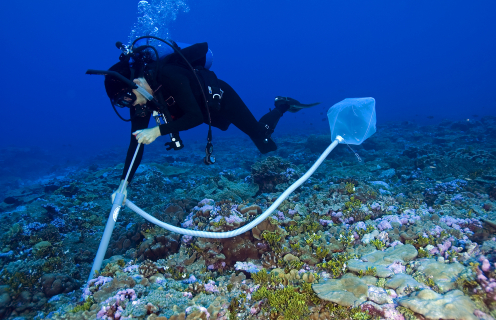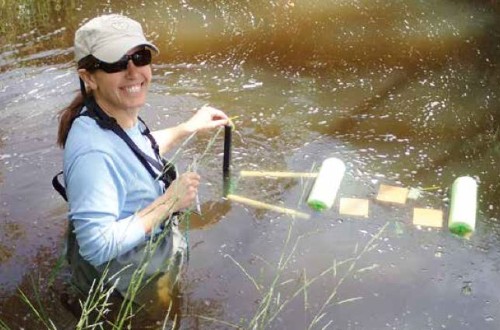eDNA & accuracy: overcoming the challenges

Sam Perrin explores how ecologists and environmental scientists are overcoming gaps in data and concerns over accuracy to integrate eDNA into their work
The enormous jumps we’ve made in genomics technology in recent decades have revolutionised every biological field that exists, be it medical science, molecular biology or zoology. The high speed and low cost at which we can now sequence DNA has opened up entirely new doors and given us the ability to ask new questions. Suddenly we can figure out what Neanderthals ate, clone threatened species to replenish populations and track the real-time evolution of a virus as it sweeps across the world.
Ecological disciplines have benefited greatly too. Over the last decade we’ve been able to find, process and analyse DNA that has been shed by different species into an environment – commonly known as environmental DNA, or eDNA. All it takes is to scoop up a vial of water, soil or even air and we have ourselves a wealth of genomic material to sequence, providing clues about all the different types of life in the surrounding area.
Yet the more ecologists use eDNA, the more we realise how difficult it is to smoothly integrate eDNA-based methods into ecological research. Fads take biologists by storm too and it’s hard to blame anyone for getting carried away with the dizzying possibilities that sequencing eDNA presents. With any new technology or sampling method, often we rush ahead blindly in excitement without investigating our use of it and avoiding the pitfalls. Has this occurred with eDNA too?
“Absolutely,” says Dr Stefania Piarulli, who works in the marine biology branch of SINTEF, one of Europe’s largest research institutes. “There are so many debates at the moment about what we can use eDNA to actually do.” That seems to be the crux of the eDNA question at this point in time – we know it’s useful, but what exactly is it useful for? Piarulli is currently working with Dr Lara Veylit and Dr Sigrid Hakvåg on a project to integrate eDNA into projects using other technologies to try to understand exactly how accurate it is. Hakvåg, a microbiologist, says that one of the potential limitations of the technology is international cooperation.
“Once we’ve collected our samples and sequenced them, for us to identify our species someone has to have sequenced them and put them in a reference library. If the genetic information doesn’t already exist in an accessible format somewhere, we wouldn’t necessarily know what we’re dealing with.”
 The ability to test for eDNA has opened up a world of possibilities for biologists - such as examining what microbial and plant life is transported in wildfire smoke - but concerns over accuracy and data persist.
The ability to test for eDNA has opened up a world of possibilities for biologists - such as examining what microbial and plant life is transported in wildfire smoke - but concerns over accuracy and data persist. A FAIR point
It’s a problem that doesn’t just plague the eDNA world. Findable, accessible, interoperable, reusable (FAIR) data is something that the global scientific community is starting to come around on, with open data sharing making its way into many research grants and data workshops now commonplace. But there’s a long way to go yet, explains Veylit, a population ecologist and the trio’s bioinformatician.
“If you want to standardise data, you need to understand how it’s collected and structured. You need to produce metadata or some sort of data description like an ontology. But researchers are already so squeezed for time and money, so you can’t just go and tell them to construct a data ontology, because most of them don’t know what that is and they don’t have time to learn it.” If scientists are struggling to do this with new data being generated, it is even harder to do retroactively for masses of data they have generated in the past.
There has been a rise in international organisations, such as the Global Biodiversity Information Facility and the Atlas of Living Australia, that help scientists share and access other data using standardised data formats. Many organisations make data open, but some don’t, opting for paywalls and profits instead.
Such organisations aren’t the only ones hoarding data. Many researchers are understandably concerned that openly sharing their raw data would lead to others using this data in other research papers and thus reducing the novelty of their own work. On top of that, language barriers prevent data sharing between many countries. A 2014 paper by Dr Tatsuyo Amano and Professor Bill Sutherland showed that over 35% of scientific literature wasn’t in English, which means it is often discarded by much of the scientific community.
Another complexity of using eDNA arises when work is done in the lands of indigenous groups. Taking eDNA samples from their land and publishing data from these samples can have profound meaning for different indigenous cultures and, as such, any eDNA projects on indigenous land requires cooperation with local communities to ensure they maintain ownership of data that is connected to their lives and histories.
Call the professionals
Dr Krista Bonfantine completed her PhD in Australia, using eDNA to monitor the effects of dam operation on river health. She’s now based at the University of Idaho, US, and is part of a lab that has been investigating bacterial and fungal microbes carried in bushfire smoke.
She says that a successful eDNA project requires at least three specific sets of knowledge. “If you’re heading into the eDNA wilderness, you need a professional guide. Full stop. That means you need an experienced academic collaborator or, if you’ve got the funds, you hire a company. There are so many pitfalls in eDNA collection and you can’t know everything. You need to know how to effectively sample the organisms and the ecosystem you’re trying to survey. You need people in a lab to extract, amplify and sequence the DNA. And you need someone to process all those strings of letters and produce meaningful counts for the taxa of interest.”
Bonfantine says the field is advancing so quickly that it pays to cooperate across labs, borders and disciplines. “We’re all on an extremely steep learning curve and it doesn’t help that we often tend to exist in siloes.”
The steepness of that learning curve means that different labs are going to be at vastly different stages along it, which results in mistakes in one lab that a lab in another part of the world learned to avoid years ago.
Barriers to international cooperation aside, the very nature of eDNA provides limitations in itself when used as a sampling tool. Much excitement surrounding eDNA stems from its ability to provide a snapshot of a community, but that snapshot will often be extremely lopsided. The inherent properties of DNA mean that even if we were to standardise sampling procedures worldwide, different ecosystems, communities and species would all present their own unique issues.
“If DNA is exposed to sunlight or higher temperatures, its lifespan will be shorter,” explains Hakvåg. If you’re in the Pacific Ocean at the equator, the same DNA will react differently if you travel 3,000km north.
Veylit adds that the converse applies too. “Different species within an ecosystem shed DNA at different rates. If you’ve got massive amounts of slug DNA compared with bird DNA, it doesn’t mean there are slugs everywhere – it could just mean that one slug species is shedding its DNA constantly.” A species doesn’t even need to shed a larger quantity of DNA for it to be present in larger quantities in your samples. Two different bacterial species can have genetic characteristics that can result in one showing up 10 times more often in a sample despite no difference in abundance.
Piarulli goes on to insist that current technology makes it difficult to quantify abundances of species in an ecosystem. “But it’s really good for assessing the presence or absence of a species, and looking at species richness in an ecosystem.”
Yet even there we find pitfalls. Just because a species shows up in a sample doesn’t mean it’s in the system the sample was taken from. eDNA from a fish may turn up in a lake well outside of the species’ expected distribution range. While sometimes this may be a result of an introduction event by humans, it could even be as simple as a bird defecating into said lake after having eaten the fish 50km away. A species may turn up in an environment at a completely unexpected time of the year – or has a low degradation rate meant the eDNA sample has simply been floating around for the last month? Even worse, a tired researcher may simply forget to change their gloves and contaminate a sample with anything from a similar species to food items.
 Dr Krista Bonfantine collects eDNA to monitor the effects of a dam on river health
Dr Krista Bonfantine collects eDNA to monitor the effects of a dam on river healthWhy does it matter?
Examples such as this may seem trivial, and for many aspects of scientific research it may not be a bother. Yet for some of the proposed uses of eDNA it could present real problems. eDNA collection could be ground-breaking for monitoring the arrival of invasive species, with locations or regions regularly sampled for evidence. This is huge – the earlier you detect an invader the easier they are to stop. If we rely solely on eDNA sampling and falsely detect a species, what’s the worst that could happen?
In 2000 Australian authorities detected the invasive black-striped mussel in Cullen Bay. They quarantined the bay and dumped 160,000 litres of liquid sodium hypochlorite and around 6,000 tonnes of copper sulphate into it. The idea involves wiping out whole ecosystems and waiting for them to be repopulated minus the invasive species. On smaller scales, lakes in the north of Europe are often treated with rotenone for similar reasons. Treatments such as this may be effective, but if done unnecessarily they are economical catastrophes and environmentally devastating.
The same goes for rare or threatened species showing up in unexpected locations. If such a species is unexpectedly detected in a new region, we may dedicate time and resources to surveying, protecting or restoring said region. If it turns out they’re not, then resources have been wasted. Relying solely on eDNA-based technology could be disastrous if it replaces more traditional methods before we’ve ironed out the kinks.
“To have meaningful ecological results, you need to combine [eDNA] with other technology,” insists Piarulli. “Sure, eDNA sampling has pitfalls, but so does any sampling method,” adds Veylit. “We’re currently developing a framework that combines eDNA sampling with a range of other techniques, such as more traditional observation data and underwater cameras.”
Getting the full picture
Combining the use of eDNA with other sampling techniques gives much more precise data on what eDNA does and doesn’t capture. The tricky thing is that due to the variation in DNA persistence and species make-up, every ecosystem is going to vary in how the different methods combine to give that full picture. So no matter where you’re starting your eDNA project, you’re going to need that combined approach. That requires a transdisciplinary team.
Thankfully, it’s now common for genomicists and taxonomists to work with field ecologists with a common question in mind. It makes scientists such as Veylit optimistic about eDNA’s future. “You need to know that you can rely on someone else to fill your knowledge gaps. It’s about having faith in the people you’re working with and about them being open to sharing. It’s not always easy in science, but it has got a lot easier in the last decade.”
Communicating the benefits of an eDNA project, as well as avoiding overpromising, also drives funding for projects and helps ecologists advance our understanding and use of the technology further. The transition over the last decade to including stakeholders at every step of the project is one that Hakvåg welcomes. “Stakeholder involvement is nothing new, but now it’s necessary. We involve social scientists and other stakeholders right from the beginning. And that creates a feedback loop where people understand better the possibilities of using eDNA and fund it further, which allows us to develop the technology.”
We may have run before we walked initially with our use of eDNA, but breaking down the walls between countries and disciplines is pushing the technology forward. I eagerly await the development of new uses of eDNA, and the ecological advances it will bring.
Dr Sam Wenaas Perrin is an invasion ecologist, climate data analyst and founder/editor of the blog Ecology for the Masses.


